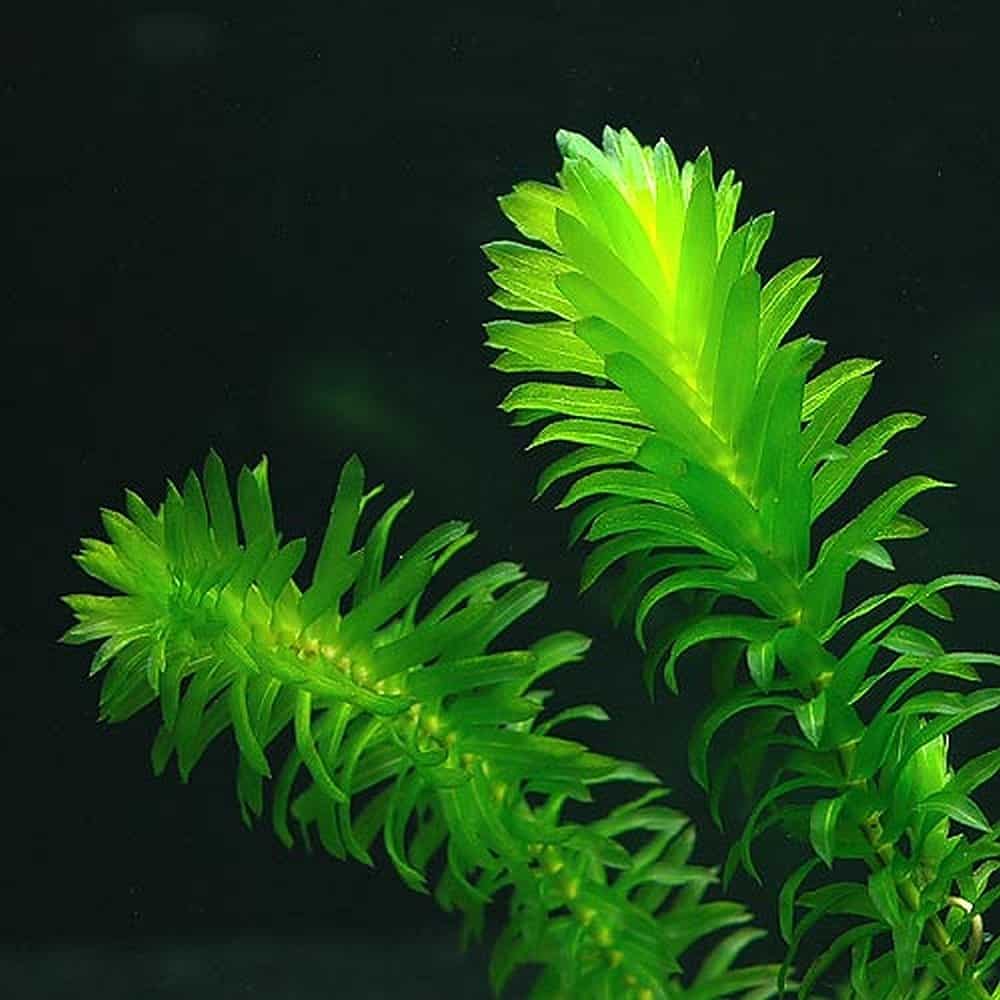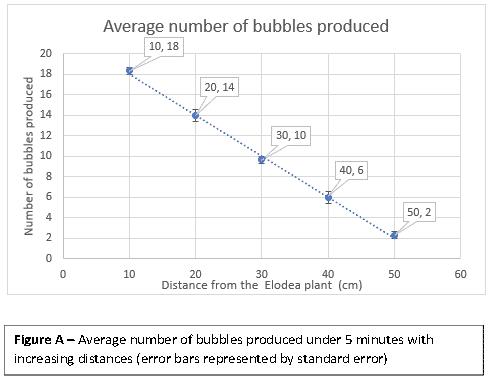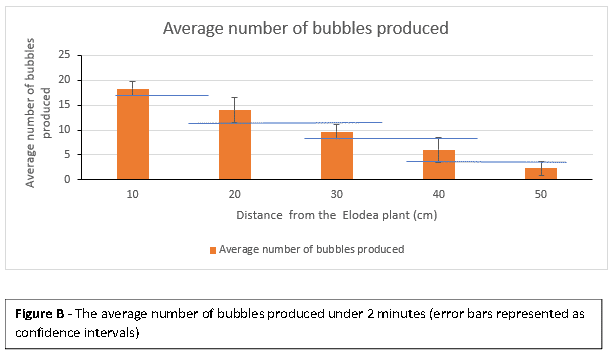Rationale

Photosynthesis represented by the equation 6H2O + 6CO2 → C6H12O6 + 6O2 is one of the most crucial chemical reactions on earth as it produces O2 molecules– a gas vital to the survival of many organisms (Vidyasagar, 2018) This process takes place during the light dependent phase of photosynthesis and is indicated by the production of bubbles and can be used to analyse the rate of photosynthesis (Benckiser, 2016).
Light intensity refers to the strength or amount of light produced and is the measure of the wavelength-weighted power emitted by a light source (Maximum Yield, 2016). The rate of photosynthesis is a function of light intensity.
The aquatic plant elodea, also known as anacharis, provides a habitat for small aquatic animals and is used frequently by fish to protect recently hatched fish (Aquatic Biologists, 2007). Elodea is very common throughout the world, particularly Oceania, and has a rapid growth rate (Asta, n.d.) It also is an excellent oxygen producer.
The rate of photosynthesis in Elodea depends on the intensity of light. With increasing, water pollution levels light that reaches aquatic plants such as Elodea significantly decreases thus leading to lesser light intensity underwater (Denchak, 2018).
Light is an important factor in photosynthesis, “how does a decreased light intensity impact photosynthetic rate of Elodea” is an important contemporary ecological question to be considered.
Research Question
How does decreasing light intensity affect the rate of photosynthesis in an elodea plant under a fixed period of 2 minutes?
Original Experiment
The research methodology used to study the above question was adapted from:
BBC Bitesize- Investigating the rate of photosynthesis, https://www.bbc.com/bitesize/guides/zpwmxnb/revision/4
The original experiment shined a light onto a large beaker filled with tap water with an elodea plant placed in it. The experiment started with placing the light 10cm away from the beaker and increased the distance by 10cm until 50cm, to decrease the light intensity at the elodea plant.
Modifications to the Methodology
To ensure that sufficient and relevant data was collected the original experiment was modified to increase the number of trials, as the original experiment only had one trial. The reliability of the data collected was improved by modifying the original methodology (see refinements). To minimize error and increase reliability, all other variables were controlled as per the original experiment.
Refined by:
Three trials from each sample will be taken to ensure sufficient data is available statistical analysis.
Leaves per elodea plant will be limited to 10 to ensure fairness in the data.
A vacuum will be created using a flask and a test tube (Appendix 1) on top of the water to ensure bubbles produced directly moved upwards in the test tube increasing the accuracy and confidence in the data.
All elodea samples were randomly chosen from a fish tank to reduce the sample bias.
Safety and ethical considerations
| Table A – Potential risks and their solutions |
| Risk | Solution |
| Use of fragile glassware | Keep all glassware away from ledges and breakages were cleaned up immediately |
| Use of water and electrical appliances | Wipe hands before handling electrical appliances |
| Risk of allergy to elodea plants | Use gloves when handling Elodea |
Processed data
Data obtained was analysed using the following statistical methods to allow appropriate interpretation of the data of the data:
The mean was chosen as the most appropriate measure of central tendency.
Standard deviation was calculated as a measure of central tendency and used to calculate standard error.
Standard error was chosen as a measure of uncertainty.
A confidence interval was chosen as a measure of validity.
| Table B – Statistical Calculations for 10cm system |

| Table C – Processed data table for the effect light intensity on rate of photosynthesis. |
| Trial Number | Calculations (Below represents distance from the light source) | ||||
| 10cm | 20cm | 30cm | 40cm | 50cm | |
| Trial1 (no. of bubbles produced) | 18 | 15 | 10 | 6 | 3 |
| Trial 2 (no. of bubbles produced) | 19 | 13 | 10 | 7 | 2 |
| Trial 3 (no. of bubbles produced) | 18 | 14 | 9 | 5 | 2 |
| Sample Size | 3 | 3 | 3 | 3 | 3 |
| Average number of bubbles produced | 18 | 14 | 10 | 6 | 2 |
| Standard Deviation | 0.68 | 1 | 0.68 | 1 | 0.68 |
| Standard Error (SE) | 0.33 | 0.68 | 0.33 | 0.68 | 0.33 |
| Confidence Interval | 1.4 | 2.5 | 1.4 | 2.5 | 1.4 |
Interpretation: The data shows that the average number of bubbles produced are in between the ranges of 18±0.33, 14±0.68, 10±0.33, 6±0.68 and 2±0.33 respectively from 10cm to 50cm. The standard error has been used as a measure of the uncertainty associated with these averages (±SE). The low standard error suggests that the results collected are close to the population mean and indicates the reliability of the mean.
The Standard deviation values obtained (0.68, 1, 0.68, 1 and 0.68 respectively) are close to zero indicating that the data is close to the expected mean of the dataset (John, 2009). The low standard error and standard deviation of the data may suggest higher precision during data collection and therefore the sample represents the accepted values (McHugh, n.d.).
Analysis– – The standard deviation of 0.68 obtained from the data for 10cm, 30cm and 50cm systems show that data is closely clustered around the mean suggesting that the data is closer to the true mean. The standard deviation of 1 for 20cm and 40cm systems suggest that the data is more dispersed away from the mean relative to that of 10cm, 30cm and 50cm systems. This may be attributed to experimental error as well as natural variations in the samples such as size of the leaves (John, 2009).

Interpretation –The graph of average number of bubbles produced vs distance (Figure A) demonstrates a linear pattern with a very strong negative correlation as demonstrated by the R2 value of 0.9981. Figure A also shows that from 10cm to 50cm, the mean number of bubbles produced (y-variable) appears to decrease in exact decrements of 4. As light intensity decreases with the distance, these observations suggest that decreasing light intensity had a negative impact on the number of bubbles produced. According to Reckitt Benckiser (2016), as light intensity decreases the rate of photosynthesis also decreases in an almost linear pattern. As the rate of photosynthesis is indicated by the number of bubbles produced the data collected fits this literature.
Analysis – As shown in figure A, the error bars are less spread out and they do not overlap at all. This suggests that results collected are all statistically significant and do not fall in the same range as each other indicating that there was a negative impact on rate of photosynthesis since the start of the experiment. According to Figure A, the error bars for 20cm and 50cm systems slightly larger (0.68) relative to that of 10cm, 30cm and 50cm systems (0.33) which may suggest the variability of the plotted data may be less precise then the other measurements.

Analysis – The data indicates, with 95% confidence, that the sample means falls within the
ranges of 18±1.4, 14±2.5, 10±1.4, 6±2.5, 2±1.4 from 10cm to 50cm respectively. Although very close, the error bars (confidence intervals) do not overlap until 30cm. However, as the overlaps in 30cm, 40cm and 50cm error bars are not extensive and therefore indicates that there is a statistical difference between all the means.
Evaluation
Limitations of Evidence
Standard error, error bars and confidence intervals are all examples of the uncertainty and limitations observed from analysis of the evidence. This can be explained by a lack of reliability and validity in the experimental process as well as the statistical sampling error.
The standard error (Table C) indicates that how far the sample mean of the data is likely from the true population mean. The natural variation within the population and the sample size cause this error. Moreover, the bubble counting error (not all bubbles in every sample were counted as some were trapped beneath leaves and some bubbles were too small to be observed by the naked eye), and the resultant errors associate with the average number of bubbles produced and statistical parameters based on that data increases the standard error.
This, in conjunction with the high standard deviation (Table C) suggests that not all variables were fully controlled and indicates low precision in the measuring devices or high random biological variation in the samples.
The small sample size of this experiment is a major factor in determining the length of the confidence intervals (Figure 2). Consequently, the evidence is limited in its ability to be used to extrapolate the findings of the experiment to the population of elodea.
Sources of Error
Most appropriate equipment to collect data were not used which may contribute to the data being inaccurate i.e. the ruler used to measure the distance between the beaker and lamp was imprecise (±0.5mm).
Human and parallax errors contribute to imprecision in the experiment I.e. the distance had approximated to a certain extent when marking it on paper and when assessing distance from above (Appendix 1) and only bubbles visible to the naked eye were counted which may affect both accuracy and precision of the experiment.
Elodea samples were not genetically screened. Therefore, random biological variation might exist within the sample. This could explain some of the remaining imprecision in the data.
Diminishing carbon dioxide, temperature variation and the time elodea plant takes to acclimatise to changed intensity of light can potentially affect the rate of photosynthesis.
The experiment was conducted in a standard classroom with opened doors and windows while students often walked past the experiment. These could have impacted the intensity of light for the experiment.
Affecting validity
The amount of CO2 in water was not pre-determined. With photosynthesis continuing the supply of carbon dioxide is rapidly used up. Hence there is the possibility that the decreased number of bubbles is a function of this.
Limiting leaves to 10 does not directly determine the number of elodea cells which may affect the rate of photosynthesis.
Suggested improvements and extensions
Suggested improvements
Reducing the random error in the experimental process would improve its reliability. In this experiment, the reliability of the data could be improved by increasing the number of trials more than once to decrease standard error due to ‘regression to the mean’ (Schnell, 2006).
To maintain the supply of carbon dioxide a compound such as sodium hydrogen carbonate can be added to the water (Benckiser, 2016).
Measure distance with a ruler equipped with a precise digital LED digital display to increase accuracy.
Light sources of different intensities should be used as this would reduce random errors. Also, the accuracy of data could be improved by using a hemocytometer to directly quantify the number of Elodea cells. (Fuentes, n.d.)
Conduct the experiment in a dark room with minimal exposure to outside factors such as open door and windows to ensure the only source of light is the lamp.
Suggested extensions
Redirect the experiment by using varying light intensities and determine the optimum light intensity for the maximum rate of photosynthesis.
Extend the experiment by investigating the effect of light intensity of various species of Elodea or different plants all together.
Conclusion
In conclusion, the evidence suggests that decreasing light intensity reduces the rate of photosynthesis in a 2-minute fixed growth period. Therefore, more pollution levels mean aquatic plants (such as Elodea) are not able to photosynthesis as well impacting the level of oxygen underwater. However, there are noted limitations in the experimental procedure such as small sample size and further statistical analysis would be required to support this conclusion.
Bibliography
Aquatic Biologists. (2007, 09 24). Elodea (Canadian Water Weed). Retrieved from Aquatic Biologists: https://www.aquaticbiologists.com/elodea-canadian-water-weed/
Asta, J. (n.d.). Rate of Growth of Elodea. Retrieved from eHow: https://www.ehow.com/info_10061234_rate-growth-elodea.html
BBC Bitesize. (n.d.). Photosynthesis. Retrieved from BBC Bitesize: https://www.bbc.com/bitesize/guides/zpwmxnb/revision/4
Benckiser, R. (2016). Rate of photosynthesis: limiting factors. Rate of photosynthesis: limiting factors, 2.
Denchak, M. (2018, 05 14). Water Pollution: Everything You Need to Know. Retrieved from Natural Resources Defense Council: https://www.nrdc.org/stories/water-pollution-everything-you-need-know
Fuentes, M. (n.d.). Cell counting equipment essentials. Retrieved from hemocytometer.org: https://www.hemocytometer.org/starter-kit/
John, T. S. (Director). (2009). Interpreting the standard deviation [Motion Picture].
Lumen. (n.d.). Describing Variability. Retrieved from Lumen: https://courses.lumenlearning.com/boundless-statistics/chapter/describing-variability/
Maximum Yield. (2016, 04 15). Light Intensity . Retrieved from Maximum Yield: https://www.maximumyield.com/definition/2036/light-intensity
McHugh, M. L. (n.d.). Standard error: meaning and interpretation. Retrieved from Biochemia Medica: https://www.biochemia-medica.com/en/journal/18/1/10.11613/BM.2008.002
Schnell, A. (2006, April 23). What Is Regression to the Mean? Retrieved from Analysis Factor: https://www.theanalysisfactor.com/what-is-regression-to-the-mean/
Vidyasagar, A. (2018, October 15). What Is Photosynthesis? Retrieved from Live Science : https://www.livescience.com/51720-photosynthesis.html
